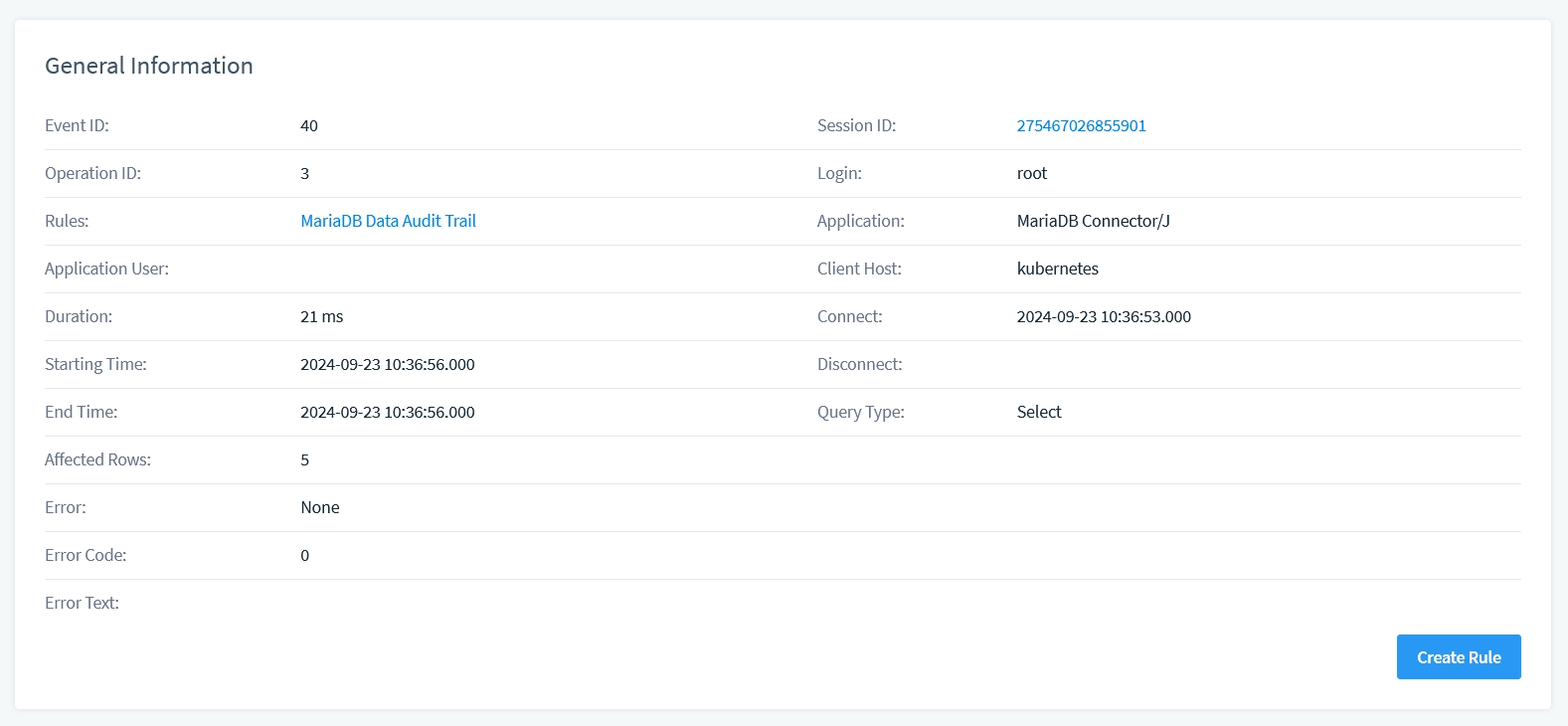
MariaDB Data Audit Trail: Ensuring Security, Compliance, and Transparency

Introduction
Tracking and recording database activity is vital for maintaining data security and regulatory compliance. A data audit trail helps organizations track changes in a database. This ensures transparency and accountability.
In this article, we will look at how a MariaDB data audit trail works. We will also discuss the tools that MariaDB provides for this purpose. Finally, we will explore how third-party solutions like DataSunrise can improve audit capabilities.
What is a Data Audit Trail?
A data audit trail is a chronological set of records that captures the activity within a database. It logs who performed specific actions, what changes they made, and when they made those changes. Audit trails are essential for:
– Tracking unauthorized access.
– Troubleshooting.
– Working with regulatory compliance.
Audit trails provide insights into how data is managed and manipulated within an organization. This visibility fosters accountability among employees, as they know their actions are monitored and recorded. It also helps identify inefficiencies or errors in data management processes.
A data audit trail alerts administrators to unusual patterns or potential threats, allowing quick responses to possible breaches. For example, if someone tries to access sensitive customer information after hours, the audit trail will record this. This allows for a quick investigation.
In MariaDB, having a data audit trail helps database administrators detect and address suspicious behavior. It also supports business accountability by providing clear visibility into database operations.
Creating a Data Audit Trail in MariaDB
MariaDB provides tools that help you create a basic audit trail. This lets users monitor and track database activities easily.
These tools can capture various aspects of user interactions, query executions, and changes in the database. They help maintain data security and compliance. Let’s take a closer look at the native tools and plug-ins that MariaDB offers for creating an audit trail:
Native Tools for a MariaDB Data Audit Trail
- General Query Log: The general query log records all client connections and the queries they execute. However, it is more useful for troubleshooting and debugging than for providing a detailed audit trail. It can slow down performance when capturing all actions.
- Slow Query Log: This log records queries that exceed a specific execution time. People usually do not use it for complete audit tracking. However, it can provide insights into performance problems and possible suspicious activities.
MariaDB Audit Plugin
The MariaDB Audit Plugin is the native tool designed specifically for auditing. It captures events like logins, queries, and changes to the database. The plugin is a more efficient and comprehensive way to manage audit trails in MariaDB compared to the general logs.
This plugin is essential for organizations that need to monitor database activity for security, compliance, and troubleshooting purposes.
Key Features of the MariaDB Audit Plugin:
- Comprehensive Logging: The plugin captures a wide range of events, such as: user login attempts (successful and failed), query executions (SELECT, INSERT, UPDATE, DELETE statements), data modifications and schema changes, connection and disconnection events
- Customizable Audit Events: Administrators can configure the plugin to log specific events based on their needs. This flexibility helps in focusing on the most critical activities, minimizing unnecessary logging, and reducing performance overhead.
- Multiple Output Formats: The audit logs can be stored in different formats.
- Compatibility: The MariaDB Audit Plugin is compatible with most MariaDB versions starting from 10.0.10, making it suitable for a wide range of database environments.
- Compliance Support: By maintaining detailed logs of all database activities, the audit plugin helps organizations comply with regulatory requirements such as GDPR, HIPAA, and PCI-DSS.
The MariaDB Audit Plugin is not enabled by default, but you can easily install and configure it.
There is another way to enhance the Data Audit Trail in MariaDB. DataSunrise offers a comprehensive platform to enhance audit trails in MariaDB.
Enhancing MariaDB Data Audit Trail in DataSunrise
DataSunrise provides an intuitive and powerful way to manage audit trails. Its functionality extends beyond basic logging, offering real-time monitoring, automated alerts, and detailed reporting. The platform can monitor specific user activities, track data access patterns, and detect any irregularities. This level of detail is particularly useful for meeting strict compliance requirements and ensuring full data protection.
Key Benefits of Using DataSunrise:
- User-friendly interface: The tool simplifies the complex task of auditing. Users can quickly set up rules and customize their logging preferences.
- Comprehensive visibility: DataSunrise provides detailed insights into who accessed the data and what actions users performed.
- Real-time alerts: DataSunrise sends alerts for strange behavior or unusual patterns. This helps administrators respond quickly to threats.
Setting Up a MariaDB Data Audit Trail with DataSunrise
The installation and setup process for DataSunrise is streamlined, so we won’t cover it in-depth here. However, it’s important to highlight that once integrated, you can start auditing your MariaDB database in minutes.
Key steps include:
- Connecting to MariaDB: The tool automatically begins monitoring activity once linked to the database.
- Customizing audit rules: Users can set up DataSunrise to watch for specific actions. This includes changes to certain tables or access to sensitive data.
- Reviewing audit logs: You can access logs in real-time. You can also create detailed reports to meet regulatory needs.
In addition, DataSunrise enables setting thresholds for generating automatic alerts. For instance, if an admin detects that more than five failed login attempts occur within a certain time frame, they can create an alert for further investigation.
You can set up the following filter statements:

Then, to perform a data audit, you can add a data filter:

How a Data Audit Trail Looks in DataSunrise
When using DataSunrise, the audit trail logs are presented in a user-friendly dashboard. Here’s an example of how it works:
– Login Attempts: The dashboard will show both successful and failed login attempts, allowing administrators to track potential security issues.
– Query Executions: You can review all SQL queries executed by users, along with the time of execution and the impact on the database.
– Data Changes: DataSunrise logs all data modifications, insertions, and deletions, providing a clear view of who made specific changes and when.
The system saves all the audit trails. The design presents them in a user-friendly manner, so you must not be a database specialist to understand them. The system can filter the audit trail by user, event type, or timeframe allowing for quick, detailed examination. For example, if an unauthorized user accessed sensitive customer data, the admin could easily pinpoint the time and the SQL queries executed by that user.

Checking every trail can provide more information. For instance, which application accessed the database, what type of query it was, etc.

Query and its results can also be saved.

As you can see, data audit trails are stored in DataSunrise in an intuitive and easy-to-access way, making it simple for users to monitor and analyze database activities. The DataSunrise platform offers a user-friendly dashboard where audit logs are organized in a clear, structured format. This design allows administrators to quickly access the details they need without sifting through overwhelming amounts of data.
Conclusion
A MariaDB data audit trail is an essential component of database security, ensuring transparency, accountability, and compliance with regulations. While MariaDB offers native tools such as the general query log and audit plugin, these may not cover all your audit needs in complex environments.
DataSunrise enhances this process by providing advanced features like real-time monitoring, user behavior tracking, and automatic alerts. Its flexibility and ease of use make it an ideal solution for businesses that require a robust, detailed audit trail.
DataSunrise is a powerful database security platform that offers a range of tools, including auditing, data masking, and discovery. Its intuitive interface and flexibility make it ideal for managing security in environments that require strict compliance. To learn more about audit trailing and see DataSunrise in action, visit our online demo.
By integrating DataSunrise with MariaDB, you can ensure that your data is secure, and that your audit trail meets the highest standards.
Next
